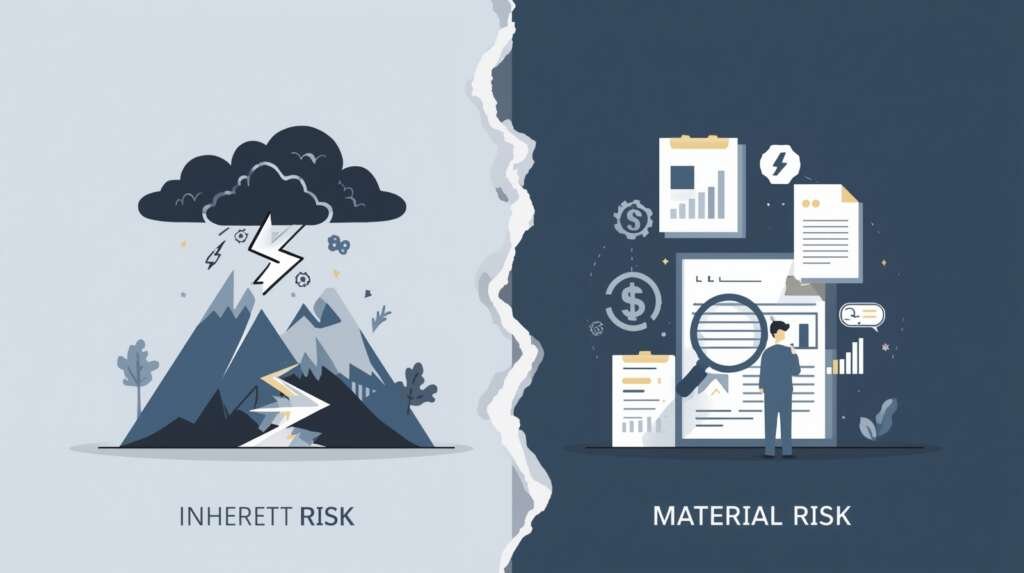Imagine your company is a new, state-of-the-art car. Before you’ve installed any brakes, airbags, or an alarm system, there’s a certain level of risk involved in driving it. That’s Inherent Risk—the “raw,” unmitigated risk that exists just by the nature of the activity itself. It’s the baseline risk you face before you’ve done a single thing to reduce it.
In the world of Anti-Money Laundering (AML) and Counter-Terrorism Financing (CFT), inherent risk comes from a few key places. A business must identify and assess this risk first, as it sets the stage for everything else. Without knowing your raw risk, you can’t possibly know what kind of protection you need.
Here’s a closer look at the key risk factors that contribute to a firm’s inherent risk profile:
1. Customer Risk: The People Behind the Transactions
Certain customer demographics and behaviors can elevate inherent risk. The question isn’t about whether a customer is criminal, but whether their profile presents a higher-than-average potential for financial crime.
- Politically Exposed Persons (PEPs): Individuals who hold or have held prominent public office, their family members, and close associates. Their position makes them susceptible to corruption and bribery, which can lead to money laundering.
- Complex Legal Entities: Shell corporations, trusts, and other legal arrangements in opaque jurisdictions are often used to obscure ownership and source of funds.
- High-Net-Worth Individuals (HNWIs): While not inherently risky, their complex financial structures and global assets can present challenges in verifying the source of their wealth.
- Cash-Intensive Businesses: Industries like casinos, certain retail businesses, and money service businesses have a higher risk of being used to launder money due to the volume of physical cash they handle.
- Behavioral Red Flags: Customers who are secretive about their identity, show an unusual urgency to move funds, or provide vague explanations for their transactions.
2. Product and Service Risk: What You’re Selling
The services your company provides are a major source of inherent risk. Some products are simply more attractive to criminals.
- Virtual Assets (VAs): The crypto sector itself is often seen as having a higher inherent risk. But the risk level varies wildly.
- Privacy Coins: VAs like Monero that are specifically designed to obscure transaction history carry an extremely high inherent risk.
- Decentralized Finance (DeFi): The permissionless and often anonymous nature of DeFi protocols means they can be exploited for illicit purposes, making them a high-risk product.
- Cross-Border Payments: Services that facilitate international fund transfers are inherently riskier than domestic transactions due to the complexities of different jurisdictions, currencies, and regulatory environments.
- New Products: Any new service or product, especially one leveraging novel technologies, will have an initially high inherent risk until it is thoroughly assessed and understood.
3. Geographic Risk: Where You’re Doing Business
The physical or digital location of your customers and business operations matters immensely.
- High-Risk Jurisdictions: Countries identified by the Financial Action Task Force (FATF) as having weak AML/CFT regimes.
- Sanctioned Countries: Any jurisdiction subject to international sanctions imposed by the UN, OFAC, or other global bodies.
- Conflict Zones: Regions with political instability or ongoing conflicts.
- Opaque Jurisdictions: Countries known for financial secrecy or a lack of transparency.
4. Delivery Channel Risk: How You Connect with Clients
The way your business interacts with its customers can also introduce inherent risk.
- Non-Face-to-Face Onboarding: Digital or online onboarding, while convenient, carries a higher inherent risk of identity fraud and synthetic identity theft compared to in-person verification.
- Third-Party Intermediaries: Relying on agents, brokers, or partners to handle customer interactions can weaken your direct oversight of the onboarding process and ongoing due diligence.
- Digital Platforms: The use of mobile and internet platforms, while essential, exposes the business to inherent risks of cyberattacks, account takeovers, and fraudulent activities.
What About Material Risk?
If inherent risk is about the potential for a break-in, Material Risk is about the consequences if that break-in actually leads to a devastating loss. A material risk is one that, should it occur, could have a significant and adverse impact on your company. This impact is so severe it could fundamentally threaten the business’s existence.
Here are the real-world consequences that define a material risk:
1. Severe Financial Penalties and Legal Action
This is often the most direct and quantifiable consequence. Regulators are levying unprecedented fines for AML/CFT failures. A material risk of non-compliance could expose your firm to penalties that could wipe out a significant portion of its capital, cripple its operations, and potentially lead to criminal prosecution for senior executives.
2. Irreparable Reputational Damage
A company’s reputation is its most valuable asset. Being publicly linked to a major money laundering scheme, a terrorism financing network, or sanctions violations can be catastrophic. It can erode public trust, deter legitimate customers and partners, and make it virtually impossible to recover your brand’s integrity.
3. Operational Disruption and Loss of License
The ultimate consequence of a material compliance failure is the loss of your license to operate. A regulator has the authority to suspend or revoke a license, effectively shutting down a business. Beyond this, a material risk could lead to a loss of access to crucial services like correspondent banking, making it impossible to operate in the global financial system.
From Raw Risk to a Secure Operation
So, we have Inherent Risk—the raw, day-one threat. We also have Material Risk—the devastating consequence. The crucial link between them is where the hard work of risk management truly happens.
- Assessing Your Inherent Risk: First, you meticulously identify and assess your raw risk.
- Introducing Controls: This is where you put your “locks, alarms, and security guards” in place. Controls are your policies, procedures, and technology designed to reduce inherent risk. This includes your KYC process, your transaction monitoring software, your sanctions screening tools, and your compliance team’s expertise.
- Measuring Your Residual Risk: The risk that remains after you’ve implemented all your controls is called Residual Risk. Your ultimate goal is to reduce your inherent risk to a level of residual risk that is low enough to meet your company’s pre-defined AML Risk Appetite.
- The Dynamic Cycle: This isn’t a one-and-done process. As inherent risks evolve (e.g., a new crypto typology emerges), you must reassess, strengthen your controls, and ensure your residual risk stays within your acceptable limits.
This is the very essence of a robust AML framework. It’s how you turn a high-risk situation into a manageable one.
Putting It into Practice: A Deeper Dive
To make this tangible, let’s look at some real-world examples:
- Customer Risk:
- High Inherent Risk: Your business wants to onboard a client who is a PEP with business interests in a sanctioned country.
- Controls: You conduct Enhanced Due Diligence (EDD). You get senior management approval, you verify their Source of Wealth through independent tax records, and you implement enhanced transaction monitoring.
- Residual Risk: The risk is now lower and may be acceptable, but it’s still higher than a standard client. You’ve actively decided to manage it.
- Material Risk: If you had not done the EDD and this client was using your platform to move illicit funds, the resulting fines and reputational damage would be a material risk.
- Product Risk:
- High Inherent Risk: Your crypto exchange is considering listing a new privacy-enhancing coin.
- Controls: You decide not to list the coin for customers from certain jurisdictions and implement stricter transaction limits on it for everyone else. You update your transaction monitoring system to flag any activity in this coin.
- Residual Risk: Your risk is lower than if you had simply listed the coin without any controls.
- Material Risk: If you had listed it without controls and it was used in a major criminal scheme, the resulting regulatory action would be a material risk.
- Delivery Channel Risk:
- High Inherent Risk: Your onboarding process is 100% online, making it vulnerable to identity theft.
- Controls: You implement advanced biometric checks and multi-factor authentication (MFA) to verify identity. You also require a small, verifiable micro-deposit from a bank account in the customer’s name.
- Residual Risk: The risk of identity fraud is significantly reduced.
- Material Risk: If you had not implemented these controls, and a criminal ring used your platform to open hundreds of fake accounts for money laundering, the resulting losses and fines would be a material risk.
The Critical Challenge: Why It’s Not Just a Checklist
Building a flawless risk assessment framework is, without a doubt, one of the most complex challenges facing financial institutions and VASPs today. It’s a task that goes far beyond simply ticking off boxes on a regulatory checklist. The difficulty lies in the confluence of several dynamic and demanding factors that require a blend of cutting-edge technology and astute human expertise.
First and foremost is the speed of innovation in crypto and FinTech. The pace at which new financial products, services, and technologies are introduced can often outstrip the speed of regulatory development. This creates a challenging environment where a risk assessment framework can become outdated almost as soon as it’s finalized. For instance, the emergence of decentralized finance (DeFi) protocols or new types of virtual assets can introduce entirely new financial crime typologies—methods of money laundering that were simply not a factor six months prior. A checklist approach, which is inherently static, is fundamentally unsuited to this dynamic landscape.
This rapid innovation is mirrored by the constantly changing tactics of criminals. Bad actors are highly adaptive, always seeking new vulnerabilities to exploit. They actively study the controls and systems of financial institutions to find weaknesses. Their methods evolve from simple structuring schemes to complex, multi-layered attacks involving multiple jurisdictions, obscured ownership structures, and sophisticated cyber techniques. This means that a risk assessment cannot be a one-time exercise; it must be a continuous process of learning and adaptation, fueled by ongoing intelligence gathering.
Furthermore, the sheer volume and complexity of data present a significant hurdle. In today’s digital world, a single customer can generate an enormous amount of data, from onboarding documents and transaction histories to on-chain activity and behavioral patterns. Sifting through this data to identify meaningful risk signals requires more than manual processes. It necessitates sophisticated technology—AI and machine learning tools—to analyze and correlate data points that a human would miss. However, these tools are not a silver bullet. They must be guided and interpreted by a skilled human operator who understands the nuances of financial crime and can apply expert judgment.
This brings us to the core of the challenge: the necessity of a blend of sophisticated technology and highly skilled human judgment. Technology can process data at scale and speed, but it cannot replace the critical thinking and experience of a compliance professional. The human element is crucial for applying context, investigating unusual alerts, and making difficult decisions about a client relationship. A risk assessment framework that relies too heavily on one over the other is destined to fail.
Ultimately, this is why compliance is not a single person’s job; it’s a strategic, company-wide commitment. It requires the active participation of the Board, senior management, legal, IT, and operations. When every department understands its role in risk management, the framework becomes a living, breathing part of the business’s operational DNA, rather than a siloed, paper-based exercise.
The Mark of a True Leader
The ultimate goal of all this effort is to move a company from being a reactive follower to a proactive leader in the financial world. The ability to master the concepts of inherent and material risk is what defines this transition. By taking the time to truly understand your raw, day-one threats, you equip your business to face the future with confidence and integrity.
A proactive leader doesn’t wait for a regulator to point out a weakness. They actively seek to understand their inherent risks—the specific vulnerabilities in their customer base, products, and geographies. They then build a robust system of controls—the right technology, policies, and people—to reduce that raw risk to an acceptable level. This “acceptable level” is what we call residual risk, and it is the true measure of a successful AML program.
This journey—from identifying your risks to building a fortress of trust—is about more than just meeting regulatory requirements. It’s about building a resilient, secure, and sustainable business that is fortified against the ever-present threats of financial crime. It’s how you protect not only your bottom line, but also your reputation and the trust of your customers, positioning your firm as a leader in a world that needs integrity now more than ever.




